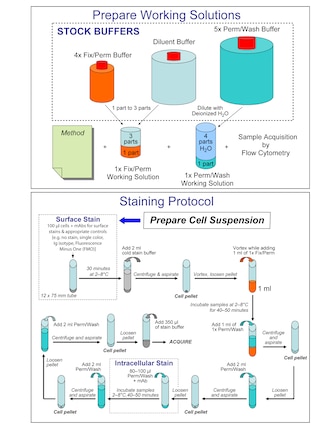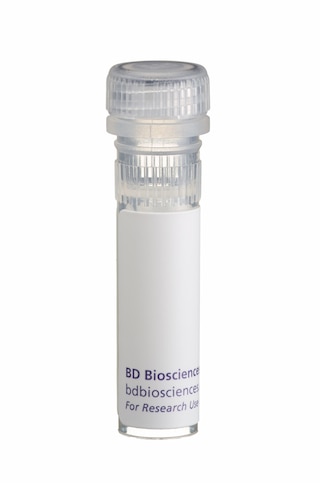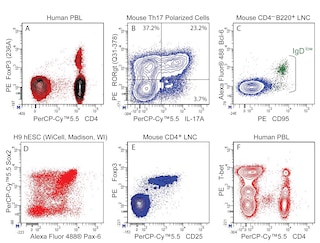Old Browser
Looks like you're visiting us from {countryName}.
Would you like to stay on the current country site or be switched to your country?


.png)

Flow cytometric analysis of IRF1 expressed in HeLa cells. Cells from the human HeLa (Cervical adenocarcinoma, ATCC CCL-2) cell line were either cultured overnight in complete tissue culture medium without (Left Panel) or with (Right Panel) Recombinant Human IFN-γ protein (10 ng/ml; Cat. No. 554617). The cells were harvested, fixed and permeabilized using the BD Pharmingen Transcription Factor Buffer Set (Cat. No. 562574/562725). The cells were then stained with either PE Mouse IgG1, κ Isotype Control (Cat. No. 554680; dashed line histograms) or PE Mouse Anti-Human IRF1 antibody (Cat. No. 566322; solid line histograms) at 0.5 µg/test. Data shown on this Technical Data Sheet are not lot specific. The fluorescence histograms showing IRF1 expression (or Ig Isotype control staining), were derived from gated events with the forward and side light-scatter characteristics of intact HeLa cells. Flow cytometric analysis was performed using a BD LSRFortessa™ X-20 Flow Cytometer System.
.png)

BD Pharmingen™ PE Mouse Anti-Human IRF1
.png)
Regulatory Status Legend
Any use of products other than the permitted use without the express written authorization of Becton, Dickinson and Company is strictly prohibited.
Preparation And Storage
Product Notices
- Since applications vary, each investigator should titrate the reagent to obtain optimal results.
- An isotype control should be used at the same concentration as the antibody of interest.
- Caution: Sodium azide yields highly toxic hydrazoic acid under acidic conditions. Dilute azide compounds in running water before discarding to avoid accumulation of potentially explosive deposits in plumbing.
- Please refer to www.bdbiosciences.com/us/s/resources for technical protocols.
- For fluorochrome spectra and suitable instrument settings, please refer to our Multicolor Flow Cytometry web page at www.bdbiosciences.com/colors.
Companion Products






The 20/IRF-1 monoclonal antibody specifically binds to Interferon regulatory factor 1 (IRF1). IRF1 belongs to the human IRF family of transcription factors that contains nine members, IRF1-9. IRF1 is broadly expressed and its levels are upregulated in response to certain cytokines, interferons, bacterial or viral infections. IRF1 binds to specific DNA motifs such as IFN-stimulated response elements (ISRE) and regulates the activity of IFN-responsive genes. IRF1 plays roles in inflammation as well as innate and adaptive immune responses. It is involved in the regulation of cellular proliferation, Major Histocompatibility Complex (MHC) antigen expression, and the differentiation and effector functions of macrophages, dendritic cells, natural killer (NK) cells, and various T cell subsets. In addition, IRF1 may function as a tumor suppressor, since deletions in the IRF1 locus is associated with myelodysplasia and leukemias.

Development References (8)
-
Cha Y, Sims SH, Romine MF, Kaufmann M, Deisseroth AB. Human interferon regulatory factor 1: intron-exon organization. DNA Cell Biol. 1992; 11(8):605-611. (Biology). View Reference
-
Ikushima H, Negishi H, Taniguchi T. The IRF family transcription factors at the interface of innate and adaptive immune responses.. Cold Spring Harb Symp Quant Biol. 2013; 78:105-16. (Biology). View Reference
-
Kim SK, Fouts AE, Boothroyd JC. Toxoplasma gondii dysregulates IFN-gamma-inducible gene expression in human fibroblasts: insights from a genome-wide transcriptional profiling.. J Immunol. 2007; 178(8):5154-65. (Clone-specific: Fluorescence microscopy, Immunofluorescence). View Reference
-
Kroger A, Ortmann D, Krohne TU, et al. Growth suppression of the hepatocellular carcinoma cell line Hepa1-6 by an activatable interferon regulatory factor-1 in mice. Cancer Res. 2001; 61(6):2609-2617. (Biology). View Reference
-
Romeo G, Fiorucci G, Chiantore MV, Percario ZA, Vannucchi S, Affabris E. IRF-1 as a negative regulator of cell proliferation.. J Interferon Cytokine Res. 2002; 22(1):39-47. (Biology). View Reference
-
Savitsky D, Tamura T, Yanai H, Taniguchi T. Regulation of immunity and oncogenesis by the IRF transcription factor family.. Cancer Immunol Immunother. 2010; 59(4):489-510. (Biology). View Reference
-
Varley CL, Bacon EJ, Holder JC, Southgate J. FOXA1 and IRF-1 intermediary transcriptional regulators of PPARgamma-induced urothelial cytodifferentiation.. Cell Death Differ. 2009; 16(1):103-14. (Clone-specific: Immunohistochemistry, Western blot). View Reference
-
Xie R, van Wijnen AJ, van Der Meijden C, Luong MX, Stein JL, Stein GS. The cell cycle control element of histone H4 gene transcription is maximally responsive to interferon regulatory factor pairs IRF-1/IRF-3 and IRF-1/IRF-7. J Biol Chem. 2001; 276(21):18624-18632. (Biology). View Reference
Please refer to Support Documents for Quality Certificates
Global - Refer to manufacturer's instructions for use and related User Manuals and Technical data sheets before using this products as described
Comparisons, where applicable, are made against older BD Technology, manual methods or are general performance claims. Comparisons are not made against non-BD technologies, unless otherwise noted.
For Research Use Only. Not for use in diagnostic or therapeutic procedures.
Refer to manufacturer's instructions for use and related User Manuals and Technical Data Sheets before using this product as described.
Comparisons, where applicable, are made against older BD technology, manual methods or are general performance claims. Comparisons are not made against non-BD technologies, unless otherwise noted.
Report a Site Issue
This form is intended to help us improve our website experience. For other support, please visit our Contact Us page.